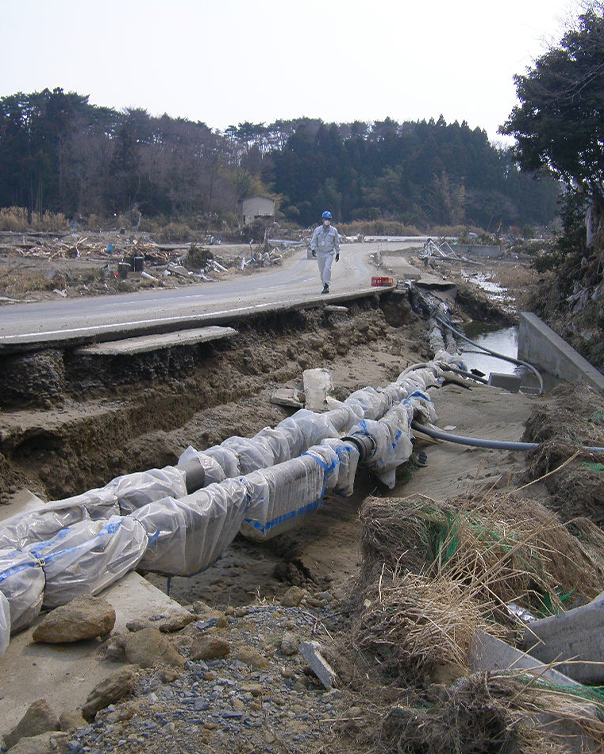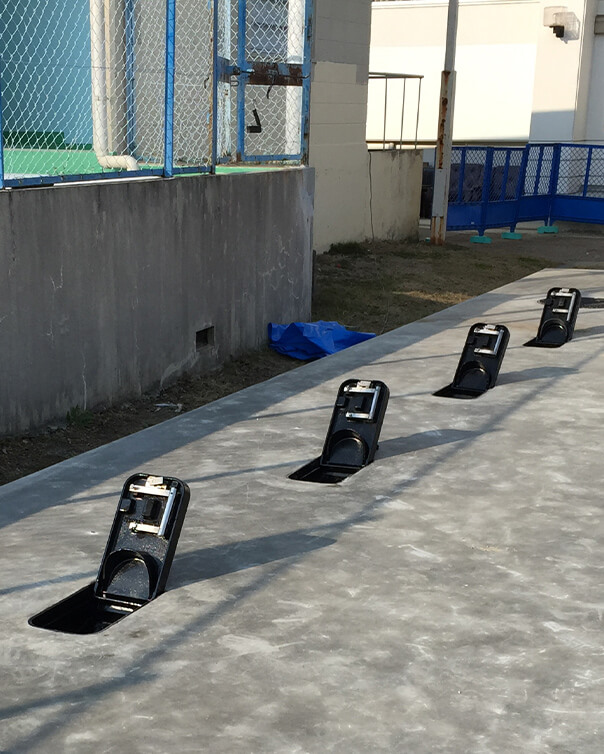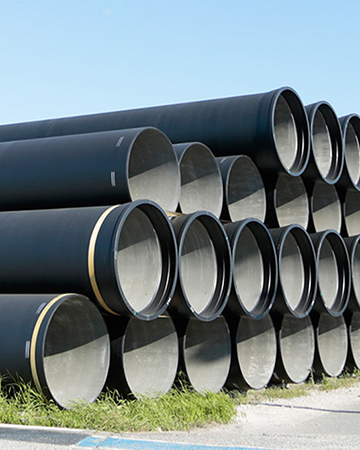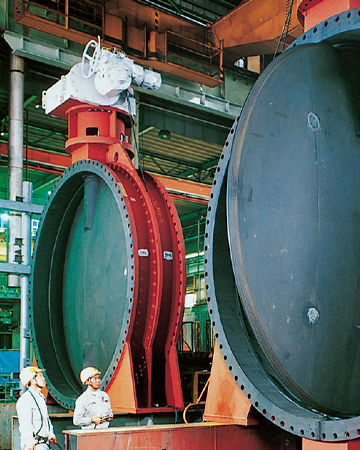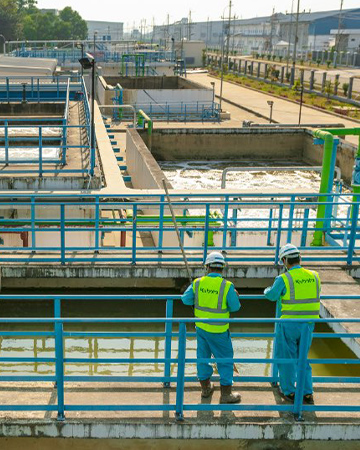
When you turn on the faucet, water comes out. That's something few people would question. Water is something that we take for granted each day.
However, a drought could reduce our water supply, or an earthquake or other natural disaster could cause an outage. There is always a possibility that we could find ourselves without available water. In anticipation of such risks, efforts are being made throughout Japan to ensure the water infrastructure that is essential for our everyday lives.
Building a Disaster-Resistant Water Infrastructure: Issues and Initiatives
Japan’s current water supply system was constructed mostly during the country’s postwar period of high economic growth, when demand was especially high, and has now achieved a 98% supply penetration rate. However, in the more than 40 years that have passed, the country has begun to face issues such as upgrades to aging facilities and delays in conversion to earthquake-resistant equipment. Approximately 2.57 million households faced water outages after the 2011 Great East Japan Earthquake, and around 446,000 households were without water after the Kumamoto Earthquake in 2016.
In response to these challenges, the Ministry of Health, Labour and Welfare (MHLW) has set forth policies, including the New Water Supply Vision in 2013 and the Guidelines for Formulating Earthquake Resistance Plans for Water Supply in 2015, to promote earthquake-proofing in waterworks facilities. Water utilities across Japan are acting on these policies by replacing aging facilities with earthquake-resistant ones to strengthen infrastructure.
Of course, there are other disasters besides earthquakes for which people must be prepared. Wind and flood damage has been occurring more frequently in recent years, and countermeasures against these threats are included in efforts by those involved in water utilities in both the public and private sectors to maintain the vital lifeline of water infrastructure.
In this article, we focus on efforts to build a stronger water infrastructure. As part of this, we will take a closer look at the long-term strategic plans of the Tokyo Metropolitan Government’s Bureau of Waterworks, Japan’s largest water utility serving approximately 13.6 million people, and the Kubota products that support its water infrastructure initiatives.
Tokyo Bureau of Waterworks’ Long-Term Strategy into the 2040s
The Tokyo Metropolitan Government's waterworks began supplying water in modern terms in 1898 and has developed to this day through a series of expansions. The Bureau of Waterworks makes its mission to support Tokyo citizens’ lifestyles and urban activities through this water supply system.
In the past, the Bureau formulated management plans with spans of three to five years. But in its Tokyo Waterworks Long Term Strategic Initiative 2020, it looks ahead to the 2040s. Mikio Toriu, Director of the Bureau’s General Affairs Division, explains that the thinking behind this is “to make sure waterworks operations can continue as the city's population declines.”

“If a time comes when the decline in demand for water supplies caused by shrinking populations has an impact on water utility rates, we will have to overcome many challenges in order to continue providing the water supply operations that serve as the foundation for city residents’ lives. This means we need to look at the water supply business from a long-term perspective as we carry out planned upgrades and other projects.” (Toriu)
The Long-Term Strategic Initiative the Bureau has formulated includes maintenance of waterworks facilities that are due for upgrades, preparations for abnormal weather and disasters, and financial measures to make these possible. The goal is to provide a stable supply of pure and high-quality water. Using this Long-Term Strategic Initiative as a compass, the Bureau is working systematically and from multiple angles to solve issues and realize sustainable water infrastructure.
Programs in the Long-Term Strategic Initiative
-
- Planned facility maintenance based on our long-term financial situation
- Water demand and facility maintenance
- Upgrade large purification facilities
- Reconstruct waterworks in the Tama Area
- Upgrade pipelines
- Disaster countermeasures
- Water quality and water source measures
- Environmental measures
- Use new technologies and streamline management
- Introduce smart water meters
- Other ICT measures
- Public relations, public hearings
- Strengthen overall strength of Tokyo Waterworks Group
- Augment our management base (business operating system)
- Secure and train human resources
- Contribute to domestic and overseas waterworks
- Financial management
How the Bureau is Preparing for Natural Disasters
Preparation for natural disasters is one of the most vital measures for realizing a sustainable water infrastructure. Earthquakes, wind and flood damage, drought, and volcanic ash fall are some of the many disasters the utility must be ready for. Among these, earthquakes and wind and flood damage have been occurring with greater frequency in recent years. “Coming up with countermeasures against these kinds of natural disasters is an urgent issue,” says Takeo Kitamura, Director for Facility Construction and Management of the General Affairs Division.

“Water supply systems suffered extensive damage in the areas affected by the Great East Japan Earthquake and the Kumamoto Earthquake. With the Great East Japan Earthquake, Tokyo also faced water outages or turbidity over wide areas due to impacts from liquefaction and planned power outages. Torrential rains that have been occurring frequently in recent years have also resulted in water outages due to flooding and damage to aqueducts*1. We have to take strong measures against these kinds of natural disasters.” (Kitamura)
- *1.Bridges constructed in locations where water pipes cross rivers or waterways.
The Long-Term Strategic Initiative takes earthquake measures as one of the most important issues, and the “hard” aspects include accelerating the reinforcement of earthquake-resistance for purification facilities, transmission/distribution facilities, and water supply pipes to the greatest extent possible.
“According to the latest data, 99.9% of Tokyo’s water pipes are durable and strong ductile iron pipes,” says Mr. Kitamura. “We are currently proceeding with conversion to earthquake-resistant joint pipes*2 that are less likely to dislodge from their joints in order to minimize the damage from an earthquake.” As of the end of fiscal year 2019, about 45% of the enormous length of Tokyo’s water distribution pipes have already been converted to earthquake-resistant joint pipes.
- *2.Chain-structured water pipes with joints that expand, contract, and bend, and that have a detachment-prevention mechanism that prevents the joints from dislodging. These pipes can also withstand subsidence and other types of ground displacement.
In terms of preparations for wind and flood damage, the Bureau is working on moving aqueducts underground and improving water intake facilities*3, along with strengthening backup functions such as installation of dual pipe systems so that water supply continues even if pipes are damaged. Steady progress is being made to prepare for natural disasters in order to minimize damage to water facilities and ensure essential water supplies in the event of a disaster.
- *3.Facilities that take in water from sources such as rivers and lakes
Before earthquake-resistance reinforcement

After earthquake-resistance reinforcement

The Long-Term Strategic Initiative calls for 100% earthquake-resistance reinforcement of the major structures in purification facilities by FY2030.
“Soft” Initiatives to Mitigate Damage and Ensure Water Supply
Countermeasures against disasters go beyond the realm of hardware and facilities. “Soft” or non-tangible measures include training to strengthen the crisis response capabilities of an organization and personnel, training to receive aid and support in the event of a disaster, and enhancing the emergency supply system if a disaster causes a water outage.

In terms of cases that reaffirm the importance of bolstering “soft” measures, Mr. Toriu mentions the damage caused by Typhoon 19 (Hagibis) in 2019. “The typhoon cut off roads in the town of Okutama, and there were also water outages. There was great confusion at that time in terms of information provided to residents and the local government. We received numerous inquiries about the state of water outages and when service would be restored, and we had to respond to them. This reminded us of the importance of communicating information and of the Bureau’s first-response system.”
With these cases in mind, the Long-Term Strategic Initiative calls for strengthening first-response and emergency water supply systems, setting up information transmission routes, and further improving public relations through the website and other means, as part of its efforts to mitigate damage through wide-ranging “soft” measures.
Tokyo’s Bureau of Waterworks is moving forward with comprehensive “hard” and “soft” measures as well as financial aspects in order to make Japan's largest waterworks network a sustainable one. “We aim for stable water supply without interruption well into the future using the technologies and systems we have cultivated,” says Mr. Toriu. Mr. Kitamura adds, “We hope to continue to develop the necessary facilities and create a robust waterworks system so that everyone can live with peace of mind.” They both express their desire to support the water infrastructure that is essential for Tokyo residents' livelihoods and urban activities.
How Kubota Products Contribute to Strengthening Water Infrastructure
In Japan, a large number of waterworks facilities, including pipelines, are due for renewal. Water utilities throughout the country are working to upgrade facilities and enhance backup functions in anticipation of natural disasters and other threats.
As people expect that a large-scale disaster could happen at any time, newly-laid water pipelines must have outstanding durability, workability, operability, earthquake-resistance, ease of maintenance, and low cost. Kubota, which supports waterworks operations with pipes and valves as well as pumps, purification treatment, and other technologies, contributes to the maintenance of water infrastructure by developing products that meet these needs.
What kinds of products help to build this portion of the robust water infrastructure? Here we will focus on Kubota's ductile iron pipes and butterfly valves, which were utilized in a construction project where water pipes were double-routed so that no water outage would occur even if the main route were damaged.
Earthquake-Resistant Ductile Iron Pipes with Outstanding Workability
Conditions at laying sites for water pipes vary widely. There can be houses and roads nearby, and sometimes rainwater, sewage, and electric wire pipes run over water pipes. Therefore, functions and sizes required for steel pipes vary. Kubota develops products that match the needs of construction sites for each pipe laying project. The ductile pipes we describe here were manufactured for piping in a shield (tunnel) installation.

Of course, this ductile iron pipe has earthquake-resistant joints. But it is also designed to reduce the working hours and installation time required for laying. In addition, a lineup of short and angled water pipes is provided to be used for sharp curves in tunnels with fewer pipes required, which contributes to cost reductions.

Butterfly Valves that Withstand Extreme Water Pressure
Butterfly valves fulfill the role of a tap for water pipes. They shut off the flow of water when there is a disaster or when repairs are being made to pipes, and they adjust the rate of flow according to the frequency of use in a community.
The dual-routed water pipes in this project are being laid to run about 46 meters below the ground surface to an above-ground distribution reservoir that is more than 10 kilometers away. The flow through the pipes has extremely high pressure and is strong enough to raise the water column 130 meters. Kubota manufactured a butterfly valve with the strength to stop this water flow and withstand its pressure.

This butterfly valve was specially designed and developed for this project. The design was drawn from scratch, the water pressure resistance strength was carefully calculated, and valve thickness and materials were developed with consideration for delivery date and cost.

Kubota has provided products and technologies related to water and the environment for nearly 130 years since it began manufacturing cast-iron water pipes in 1893. The company continues to support Japan's water infrastructure to this day through products that meet a wide range of on-site needs.

